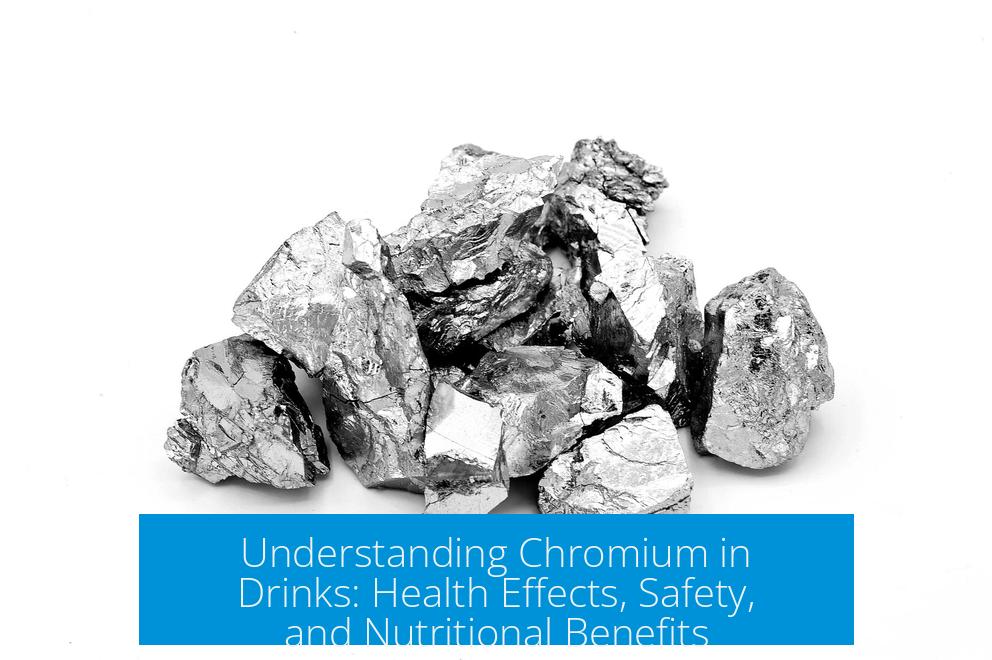Chromium in Drinks: What You Need to Know
Chromium is a trace mineral your body needs, but its role in beverages and supplements is often misunderstood. It exists mainly in two forms: chromium(III) (Cr(III)) which is considered nontoxic, and chromium(VI) (Cr(VI)) which is highly toxic. Only Cr(III) appears in food and drinks.
Chromium as an Essential Trace Mineral
Chromium is classified as an essential micronutrient. The body requires it at trace levels, supporting normal metabolic processes. It is naturally present in several foods but is also added to supplements and some drinks.
Chromium Content in Drinks and Supplements
Some products boast high chromium percentages, such as 40% of the daily value in one beverage. This high percent can be misleading because daily recommended values are very low. For example, an amount small enough to fit in a drink may already reach 100% of the daily requirement.
Forms of Chromium and Safety
- Cr(III): Non-toxic, naturally found in foods, safe in supplements.
- Cr(VI): Toxic, not present in drinks or supplements.
This distinction is crucial because only Cr(III) is intended for consumption.
Health Claims and Scientific Evidence
Some sports and health drink producers claim chromium in the form of Cr(III) improves performance or health. These claims stem from early rodent studies where animals fed chromium salts exhibited non-toxic effects and slight weight gain. However, human studies have not consistently confirmed these benefits.
Despite marketing, chromium(III) does not show conclusive effects on body weight or energy in humans. Skepticism remains regarding its efficacy as a performance enhancer.
Chromium in Weight Loss and Energy Combinations
Chromium sometimes pairs with green tea extracts in over-the-counter supplements targeting weight loss and energy. Some research hints at modest effects, but they remain limited. For further reading, the NIH provides an informative dietary supplement fact sheet: NIH Weight Loss Supplements.
Considerations When Consuming Chromium-Containing Drinks
- Percent daily values can be misleading due to very low recommended amounts.
- Products may have numerous ingredients; complex formulations may raise concerns about interactions.
- High sodium content (e.g., 270 mg per can) may affect overall health, especially if consumed frequently.
Key Takeaways
- Chromium in drinks is mainly Cr(III), a non-toxic trace mineral.
- Claims that chromium boosts metabolism or performance lack strong human evidence.
- Chromium is often combined with green tea for weight loss but results are modest.
- Read labels carefully: percent daily values and ingredient lists can be misleading.
- Watch for high sodium content in chromium-containing beverages.
What forms of chromium are found in drinks, and are they safe?
Drinks typically contain chromium(III), which is safe and nontoxic. Chromium(VI) is toxic but is not present in beverages. Only chromium(III) is used in supplements and health drinks.
Do chromium-containing drinks effectively improve health or sports performance?
Claims that chromium(III) boosts health or athletic performance lack solid evidence. These claims come from studies on animals where chromium was non-toxic but did not show clear benefits to humans.
Why do some drinks show 40% or 100% chromium content on labels?
Percent daily values can be misleading because they refer to a very small recommended chromium intake. High percentages may only represent trace amounts, not large doses.
Are chromium and green tea combinations in drinks proven for weight loss?
Some studies support the use of chromium combined with green tea for weight loss and energy. The NIH has articles noting these effects, though results may vary.
Should I be concerned about other ingredients in chromium drinks?
Many chromium drinks contain multiple ingredients, including high sodium levels. It’s important to check the full ingredient list, especially for those watching salt intake.





Leave a Comment